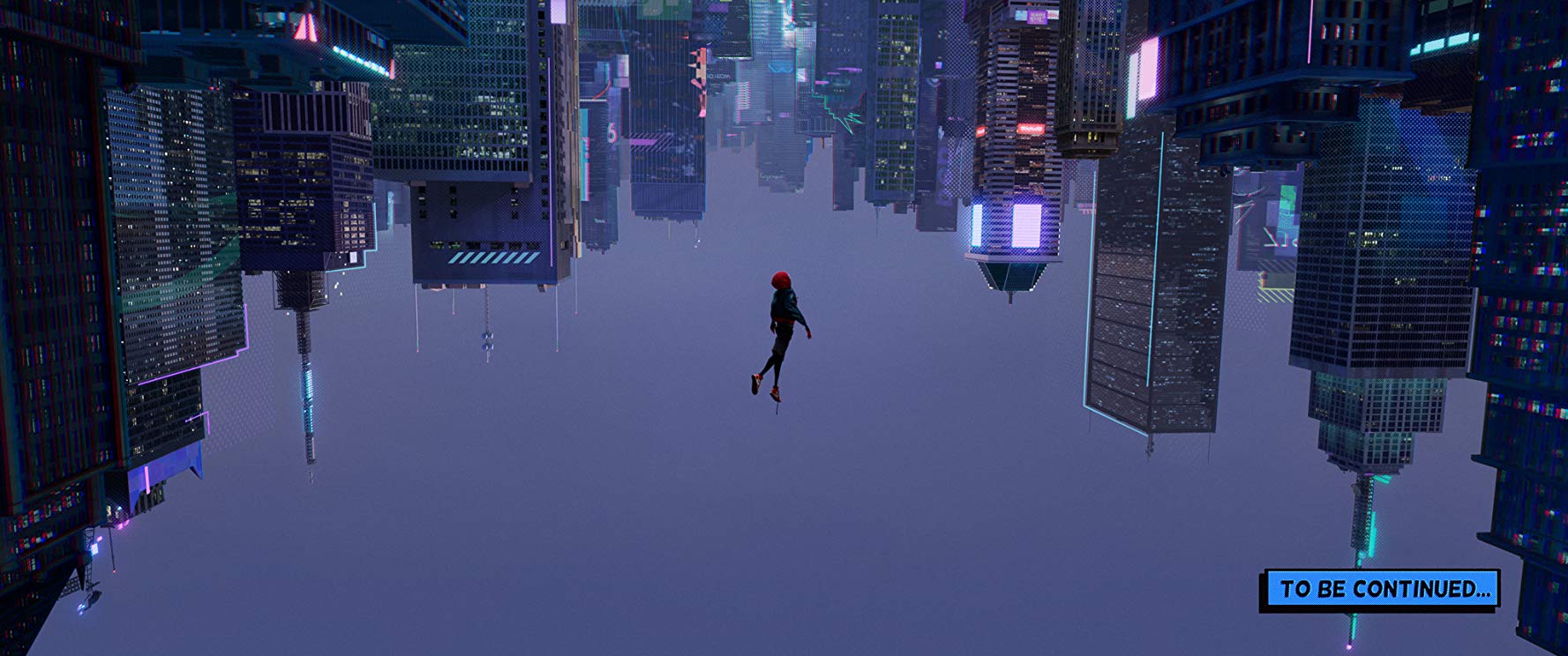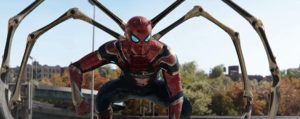On top of a New York City skyscraper, a teenager clad in the blue-and-red Spider-Man suit hangs over the edge, gazing at the cars on the streets below. This is not an unusual sight: since 2002, the world has seen six films solely dedicated to Spider-Man. It’s easy to predict that he will shoot a web, jump over the edge, and swing away to fight crime.
But this isn’t Peter Parker, the web-slinger from Queens adapted over and over again for the big screen. Instead, it’s Miles Morales (Shameik Moore) making his cinematic debut, questioning if he can continue Parker’s legacy.
It isn’t an easy question, not in our universe or in Miles’. Having been bitten by a radioactive spider (and finally realizing that his newfound reflexes are powers and not puberty), the Brooklyn-raised teen witnesses Kingpin (Liev Schreiber) open an interdimensional portal and kill the original Spider-Man (Chris Pine). Figuring out how to be a web-slinging hero and stopping a mob boss is hard, but Miles is not alone for long, as Spider-Men and Women start pouring through from different dimensions. Soon, he runs into Peter B. Parker (Jake Johnson), a disheveled version of the Spider-Man from his dimension, as well as badass Spider-Gwen (Hailee Steinfeld), cartoonish Spider-Ham (John Mulaney), anime-styled Peni Parker (Kimiko Glenn), and gritty Spider-Noir (Nicolas Cage).
Writer-producer Phil Lord and producer Chris Miller—who previously worked together on 21 Jump Street (2012) and The Lego Movie (2014)—step into the oversaturated market of superhero films and deliver a fresh look at a classic character by breaking every rule. Like Miles’ story, it’s not about fitting into someone else’s mask. It’s about making their own.
Spider-Man: Into the Spider-Verse is an animated film, but its style is drastically different from any other animation out there. Instead of mimicking the Pixar style, Lord and Miller pay homage to classic comic conventions. Miles’ universe is built entirely with Ben-Day dots, a printing process used in older comic books for color and optical effects, making it look as if the film was hand-drawn. The interdimensional portal sparks in distinctive Kirby Krackles, a comic technique created by artist Jack Kirby to show energy fields and blasts on the page. There are also more mainstream effects interspersed throughout: Miles’ thoughts are captured in bubbles or captions, actions turn into visual sound effects, and Spidey senses are drawn as lines on top of characters’ heads.
It’s a bold, brilliant choice, and Lord and Miller never hold back. Fight scenes and web-slinging sequences are framed into panels, making the film, if paused, look indistinguishable from a comic book. In fact, when Peter B. Parker explains his plan for invading Kingpin’s lab, his narration turns into a literal comic book, with his actions being animated onto individual panels. Into the Spider-Verse is a graphic novel that burst into life, making it a one-of-a-kind experience and a strong case for watching in theatres. The incredible attention to detail, even down to the minute rays radiating from the sound of knocking on doors, make it worth the ticket price.
Matching this bold visual style is the movie’s new Spider-Man, Miles Morales. Despite sharing the screen with six different heroes, Miles is the heart and soul of the story. Part of what makes Miles such a captivating protagonist is just how relatable he is. He hums along to Post Malone songs, he easily flips to speaking Spanish with his mother (Luna Lauren Velez), and he is embarrassed by his dad (Brian Tyree Henry) dropping him off at school. Like many teenagers, he feels like he doesn’t fit in. He struggles to make friends at his new school, and he doesn’t think he can meet his parents’ expectations to succeed in it. The only time he seems to have found himself is when he is spraying graffiti with his Uncle Aaron (Mahershala Ali) after trespassing into an illegal area of the metro. It’s easy to cheer for Miles because his struggles are so real and vivid: he just desperately wants to find his place in the world. When he gets bitten by the spider, there’s hope that this is what is going to change everything.
But, as Miles constantly struggles to swing away and fight villains, it’s clear that the spider wasn’t the answer to all of his problems. Even his powers become a hazard, especially when he finds himself stuck to walls or ceilings mid-way through a battle. When the other heroes confront him on whether he’s ready to don the Spider-Man mantle, he collapses on the floor and doesn’t get back up.
These struggles are heart-wrenching to watch. Most superheroes easily fight back, they get attacked by armies of CGI aliens or robots and win without a single scratch. They are born for that role, but Miles is different. Miles wasn’t born to be a hero, and he can’t be turned into one. He has to choose to be Spider-Man. He has to actively learn and struggle and fight, even if he is scared. The spider gives him powers, but it doesn’t make him a hero—he has to believe that he can be one.
“It always fits, eventually,” Stan Lee tells Miles as he gives him a Spider-Man costume. Into the Spider-Verse, dedicated to Lee and Steve Ditko who both passed away in 2018, provides the best tribute possible to the character’s creators. It honors past illustration techniques and storylines, while still carrying that spark that made Spider-Man, someone who chooses to use their powers to save the day, so special. As Miles dives into the New York City skyline in his graffiti-colored black suit and Nike sneakers, he successfully makes his big screen debut by continuing that legacy in his own style, reminding everyone that they, too, can be a hero.





